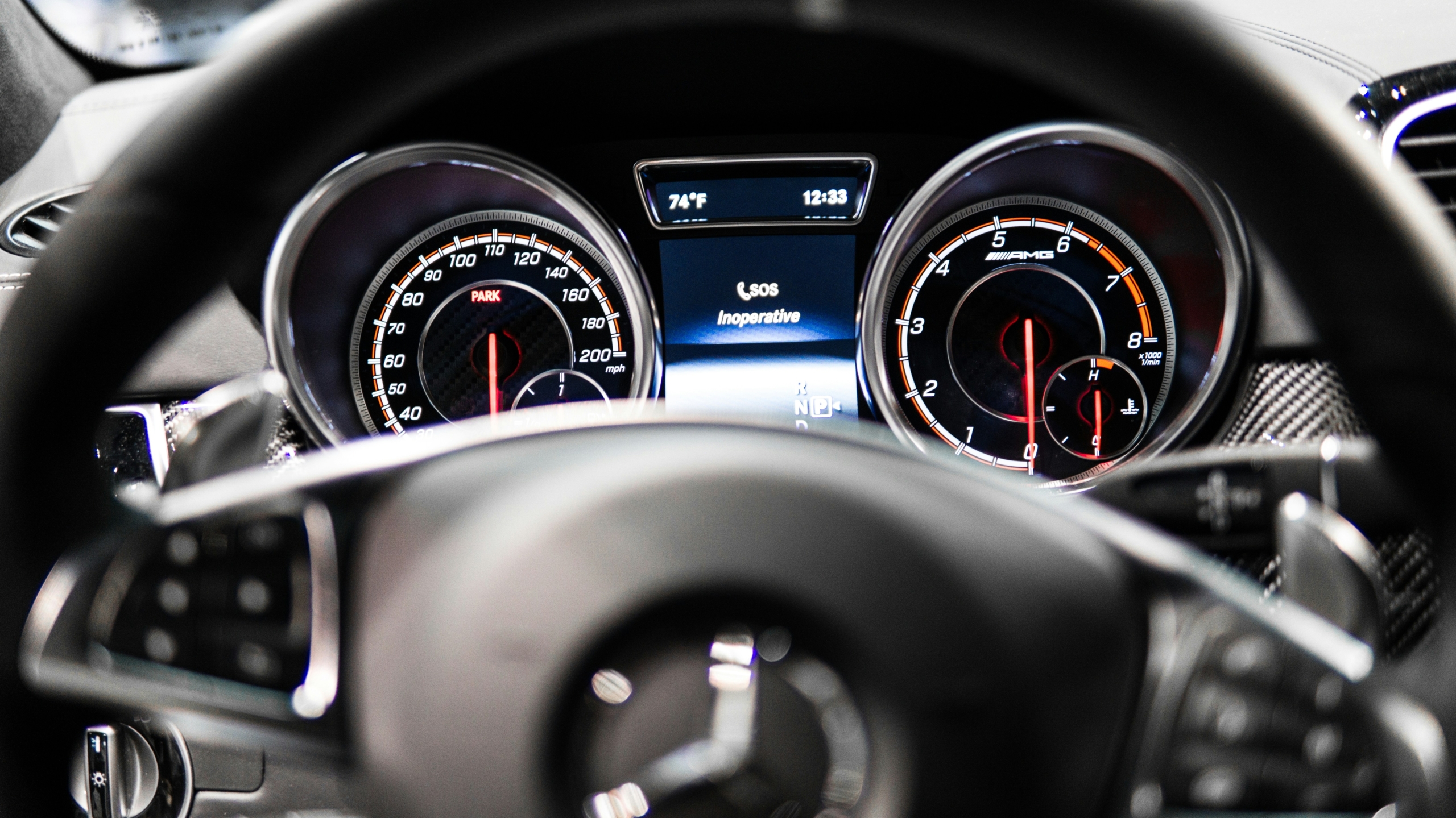
- Why Familiarize Yourself with the Vehicle Before Driving It
- Top 5 Things to Do Before You Drive
- Vehicle Controls and Their Functions
- Adjusting Seats and Mirrors for Maximum Safety
- Dashboard Symbols You Need to Know
- Getting Acquainted with Vehicle Safety Features
- What to Expect in Driven2Drive’s Driver’s Education Course
Familiarizing yourself with the basic functions of a car is one of the first steps in becoming a responsible driver. Before your foot even hits the gas, you should always take a moment to assess the different functions and controls of the car you’re in.
This is true regardless of whether it’s your first time behind the wheel or you’re a seasoned driver. While most cars offer the same standardized functions, they may be somewhere else in each vehicle depending on the make and model, so it’s still important to assess where they are before driving.
What You Will Learn
In this post, we’ll look at the key vehicle controls and functions you should know, including dashboard symbols, safety features, and how driver’s education courses can help you tie all your knowledge together.
- Understanding Essential Vehicle Controls
Gain insights into key vehicle controls such as steering wheel, accelerator, brakes, gear shifts, dashboard symbols, and how they function. - The Importance of Familiarization Before Driving
Learn why it’s crucial to familiarize yourself with vehicle features—like adjusting seats and mirrors—before driving for safety and performance. - Dashboard Symbols Explained
Discover the significance of various dashboard symbols and what they signal about your vehicle’s health, including check engine lights, tire pressure warnings, and brake system alerts. - Pre-Driving Safety Checks
Find out the essential steps to take before driving, such as adjusting your seat, and mirrors, checking dashboard symbols, and planning your route. - Vehicle Safety Features
Explore critical safety features such as airbags, seat belts, ABS, and traction control to understand how they protect you in emergencies.
Why Familiarize Yourself with the Vehicle Before Driving It
When you first get into a new car, it’s important to take a few minutes to get familiar with it. Not every car is going to have the same buttons in the same places, so learning where all the essential features are before you start driving will make you feel safer and more confident.
Understanding basic vehicle components, like the steering wheel, brakes, mirrors, gear shifts, dashboard indicators, and others, can help new drivers operate a car more smoothly and improve driving performance by helping the driver make quick, informed decisions. In Unit 2 of our Driven2Drive driver’s education program, we’ll focus on introducing basic features you can find in any vehicle more in-depth to set up new drivers for success on the road, no matter which car you’re driving.
Top 5 Things to Do Before You Drive
Before you even stick the key into the ignition or turn the engine on, there are five key things you should always do before driving:
1. Adjust Your Seat and Mirrors
To make sure you’re comfortable and can properly control the vehicle, make sure your seat is positioned correctly in front of the steering wheel. Your mirrors should be adjusted as well so that you can fully see what’s behind you.
2. Familiarize Yourself With Dashboard Symbols and Lights
Start looking at the different vehicle controls you use most often. These can be essential features like brakes, gear shifts, windshield wipers, and hazard lights. You can also look at comfort features such as temperature and the radio to make sure you’re not distracted by trying to figure it out while driving.
3. Check Dashboard Symbols
Learn the main dashboard warning lights in the vehicle and what they mean. This will help you avoid confusion if a light comes on when you’re driving. We’ll look at specific lights and symbols and what they indicate a bit later on in this post.
4. Know Where Safety Features Are Located
Take a moment to understand where the driver and passenger airbags are as well as emergency brakes, seat belts, and the hazard lights button. You can also check the trunk of the car to see if any emergency gear is already there, like a jack, tool kit, and spare tire.
5. Plan Your Route Before Driving
If you don’t know your route without looking at a map, set up your hands-free GPS before you begin driving. This can help remove distractions from a car screen or your phone while driving and helps you feel more confident in where you’re going.
Vehicle Controls and Their Functions
No matter the model, make, or year of a vehicle, there are some functions that come standard in all cars. Below, we’ll look at the key vehicle controls you should understand and their functions:
Key driving functions
- Steering wheel: Controls the direction of the vehicle; crucial for maneuvering safely
- Accelerator (gas pedal): Increases the vehicle’s speed when pressed
- Brake pedal: Slows down or stops the vehicle; essential for safe stopping distances
- Gear shift/transmission: Allows the driver to change gears (e.g., park, reverse, drive); critical for controlling vehicle speed and direction
- Clutch (manual transmission): Engages and disengages the engine from the transmission for smooth gear shifts
Dashboard functions

- Speedometer: Shows current speed
- Fuel indicator: Displays remaining fuel
- Gauges (temperature, RPM, etc.): Monitors vehicle performance and warns of potential issues
- Turn signal: Shows when a turn signal is on
Adjusting Seats and Mirrors for Maximum Safety
How to Properly Set Your Side Mirrors
To make sure you’re both comfortable and safe while driving, adjust the driver’s seat and all your mirrors before setting off. Here are some steps to follow to make sure your seat and mirrors are adjusted correctly:
- First, adjust your seat. Move it forward or backward so your feet easily reach the pedals.
- Adjust the seat height so you clearly see the road and dashboard, your knees should rest comfortably below the steering wheel without touching it.
- Next, make sure your back is fully rested on the seatback and the headrest is positioned to support the back of your head.
- Now that your seat is adjusted, set the side and rearview mirrors to minimize blind spots.
- Move the side and rearview mirrors until you have a clear view of the sides of your vehicle and through the back window.
- Finally, adjust the steering wheel by moving it up or down and forward or backward so that it’s at chest height and you can easily reach it with a slight bend in your elbows.
Dashboard Symbols You Need to Know

It’s important to understand what a symbol means if it comes on while you’re driving or when you turn a vehicle on. Some lights can be warnings, and some can indicate that your vehicle needs immediate attention to function properly. Here are some of the main symbols and lights that can pop up on your dashboard:
- Check engine light: Indicates engine or emissions system issues
- Battery light: Signals a problem with the vehicle’s charging system
- Oil pressure warning: Warns of low oil pressure in the engine
- Brake warning light: This can indicate a problem with the braking system or low brake fluid
- ABS light: Alerts a malfunction in the Anti-lock Braking System
- Tire pressure warning: Shows low air pressure in one or more tires
- Seatbelt reminder: Reminds the driver or passengers to buckle up
- Fuel indicator: Warns of low fuel levels
Getting Acquainted with Vehicle Safety Features
Every vehicle is equipped with a number of safety features that get triggered in the event of an accident. It’s important to familiarize yourself with the features below in the event of a collision:
- Airbags: Deploy in a collision to cushion and protect passengers
- Seat belts: Restrain passengers, preventing them from being thrown in sudden stops or crashes
- Anti-lock braking system (ABS): Prevents wheels from locking up during hard braking
- Traction control: Maintains grip on slippery surfaces by managing wheel spin
For new drivers especially, it’s crucial to understand these safety features to build confidence on the road. It can be reassuring to know that the car you’re in is equipped to handle emergencies and improve overall driving performance.
Key Takeaways:
- Becoming Familiar with Your Vehicle is Crucial for Safety
Learning where the essential controls are and understanding their functions leads to better driving decisions and safer experiences on the road. - Pre-Drive Checks Can Prevent Distractions
Adjusting mirrors, seats, and setting your route beforehand ensures focus while driving, reducing the risk of accidents. - Understanding Dashboard Symbols Prevents Mechanical Issues
Recognizing warning symbols on your dashboard helps you respond appropriately and avoid potential vehicle breakdowns. - Driver Education Courses Can Help You Master the Basics
A structured driver’s ed course, like the one offered by Driven2Drive, enhances your knowledge of vehicle operation and safety practices through hands-on training.
What to Expect in Driven2Drive’s Driver’s Education Course
In Driven2Drive’s driver’s ed course, you’ll dive deeper into key vehicle operations and safety practices. You’ll learn the basics of vehicle controls while getting hands-on experience to make the learning more memorable. Your Driven2Drive instructor will also emphasize the importance of different safety features, let you test out different car functions, and help you feel more comfortable on the road.
In addition to basic vehicle features, you’ll learn essential driving skills, like how to handle different road conditions, parking, and what to do in emergencies. The highlight of Driven2Drive driver’s education courses is that they can be fully tailored to each driver’s specific needs, whether that’s classes in the evening, more time behind the wheel, or more time to review theory.
Driven2Drive offers premier driver’s education classes in Philadelphia, helping students tackle the challenges of all kinds of driving, from busy cities to suburban areas, urban roads to packed highways, and more. With Driven2Drive, you can book a lesson package that fits your unique needs and schedule and find peace of mind knowing that our professional instructors will be alongside you every step of the way.
Explore how Driven2Drive can help you master driving fundamentals
FAQs
Why is it important to understand vehicle controls before driving?
It’s important to understand at least basic vehicle controls to safely operate a car and build confidence on the road. It can also help you avoid getting into accidents by being able to quickly respond by using the right feature at the right time.
How do I adjust my car mirrors for safe driving?
You can adjust your car mirrors by positioning the side mirrors to show the edge of your car and the rearview mirror to center the back window. This will minimize blind spots and help you get the most visibility in those hard-to-see areas.
How can I get more hands-on training with vehicle controls?
To get more hands-on training with vehicle controls, you can practice in a safe, controlled environment like a parking lot or enroll in a driver’s education program with Driven2Drive for more guided and personalized instruction.
Related Resources
- Preparing Your Teen for Driver’s Ed: Getting Ready to Drive
- Stick Shift Driving Lessons: Mastering the Manual
- What to Keep in Your Car? 10 Car Necessities for New Drivers

Ronit Tehrani is the Founder and Co-Owner of Driven2Drive, a premier driving and license testing center in Philadelphia. Since 2013, she has been dedicated to providing safe driving education and skills for lifelong success. Under her leadership, Driven2Drive became Pennsylvania’s first privately owned PennDOT-certified testing center, now with six locations.
